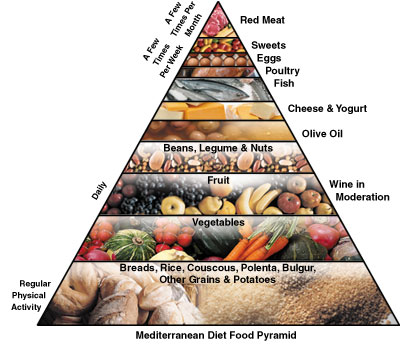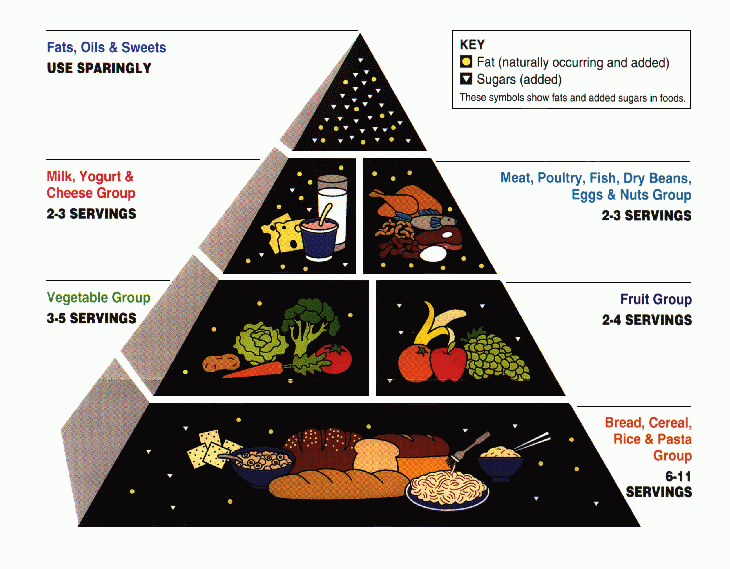Introduction
The Mediterranean Diet (MD) was inspired by the traditional dietary patterns of the sixteen or so countries in the Mediterranean region. First publicized in 1945 by American doctor Ancel Keys, the diet gradually gained attention and then popularity in the 1990s. The plan, which delivers as much as 40 percent of total daily calories from fat, is unique in that the associated incidences of cardiovascular disease are significantly reduced. The exact opposite of what one would expect to see in a diet full of fat. The key however appears to lie in the types of fats consumed.
Promise
You can lower your risk of heart disease and cancer by following this heart-healthy approach to eating.
Premise
The plan does not set out to limit total fat consumption. Instead, it discourages the eating of bad fats (saturated fats and hydrogenated oils) and encourages the consumption of healthier fats such as olive oil and polyunsaturated fats.
Program Overview
There is no set diet program. This approach to eating is loosely based on the types of foods eaten and the lifestyle followed by the people of the Mediterranean region. This means participants incorporate:
1. Plenty of exercise.
2. Generous amounts of fruits and vegetables.
3. Healthy fats (olive and canola oils).
4. More herbs and spices instead of salt to flavor food.
5. A small portion of tree nuts into their diet.
6. Red wine consumption in moderation.
7. A limited amount of red meat.
8. More coldwater fish into weekly meals.
Foods
The program traditionally includes generous daily servings of fresh vegetables and fruits, potatoes, beans, and seeds. Fish is eaten on a regular basis, which is also a great source of Omega 3 fatty acids. Nuts, though high in fat (80% of calories coming from fat), are allowed, tree nuts, specifically, as they are low in saturated fats. Therefore a handful a day of nuts like walnuts, pecans and hazel nuts, are permitted. Fish and poultry are consumed in low to moderate amounts, and eggs are consumed no more than four times a week.
The MD food pyramid looks like this:

For comparison, take a look at the USDA food pyramid:

As you can see, they do differ. The MD calls for less consumption of red meat and more fresh vegetables (typically nine servings a day). Under the MD plan, more freshwater fish and nuts are consumed and are not grouped with red meats, as they are in the USDA food pyramid shown below.
Plan Strengths
In comparison to some other diet programs, the MD is less restrictive and does not require complicated planning or formulas to follow. Smart shoppers can easily adopt the MD, as the focus is on choosing plenty of fresh vegetables and fruits, limiting red meat, and eating fish at least twice a week.
The diet has been studied for years and has numerous scientific studies to back it up. One of the longest studies followed 2,500 people for twelve years and found a significant decrease in body weight, blood pressure, blood fats, sugars, and insulin levels in people who followed the plan. Another U.S. study released in 2007 found that both men and women who followed an MD were able to lower their risk of death from both heart disease and cancer.
The program may improve more than just our physical health as well. A study published in the Archives of General Psychiatry in 2009 showed that people following this plan were less likely to develop depression. Another study conducted by Colombia University Medical Center found participants who followed the diet had a 40 percent less risk of developing Alzheimer’s than those who followed a more typical Western diet regimen.
Plan Weaknesses
While the plan has gained in popularity over the years as a diet and weight loss program, it is not really a weight loss program. People have however reported losing weight while following this healthier eating plan.
Even though a higher percentage of the calories on this program come from good fat sources, people have been known to over-indulge and consume too many “good” fat calories. A big miscalculation as any fat – good or bad – eaten in excess will cause someone to add on the pounds.
Individuals constantly on the go, who survive on fast food and convenience foods, will struggle to follow the diet, as they need to consume fresh foods and spend some time cooking. Additionally, people with an allergy to seafood or nuts may find the food choices limiting.
Conclusion
Calling the Mediterranean Diet a diet program is a misnomer. It is more than a diet; it is a lifestyle, which promotes a healthier and longer life by eating sensibly and exercising regularly. Fresh healthy foods, controlled portions and the consumption of mostly healthy fats are the earmarks of an MD. While weight loss may be a fringe benefit for many participants, the best health rewards will likely be your ability to prevent diabetes, heart disease, and certain cancers.
The information provided here is for educational or informational purposes only. Dave DePew does not endorse any of the programs/services reviewed here. Before starting a new exercise regime or weight loss plan, talk with your doctor.
Additional Resources
Mediterranean Diet
American Heart Association, http://www.americanheart.org/presenter.jhtml?identifier=4644
Mediterranean diet for heart health
MayoClinic.com, http://www.mayoclinic.com/health/mediterranean-diet/cl00011
Popular Diets of the World: The Mediterranean Diet
WebMD, http://www.webmd.com/diet/features/the-mediterranean-diet
The Mediterranean Diet: Can it Reduce Your Risk for Heart Disease?Women’s Heart Foundation, http://www.womensheart.org/content/Nutrition/mediterranean.asp
